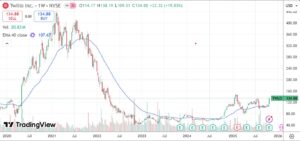Structured Products: Market Mechanisms, Risks, and Tactical Responses in the Current Cycle
Structured products are hybrid financial instruments combining bonds, derivatives, and market-linked assets to create customized payouts and risk profiles. Often marketed for fixed income and “safety”, these products may expose investors to substantial principal losses when market conditions change, especially if underlying equity triggers are breached. Recent history involving Twilio Inc. (TWLO) illustrates crucial tactical considerations and risk management.
Case Study: Downside Conversion of a Structured Product
After a liquidity event in Singapore, a client was advised to invest exit proceeds in two structured notes, both offering double-digit fixed coupons (12% and 16%) tied to technology stocks. Labels such as “safe” and “guaranteed” were used frequently. However, as those stocks fell sharply and breached floor triggers, the notes were converted into direct equity holdings at low market prices, with coupon payments discontinued.
Twilio’s price action exemplifies the mechanism: From a 2021 peak above $400, the stock corrected to under $40, currently consolidating at $135 as of November 2025. Investors who held structured products with TWLO as the underlying saw principal converted when the floor was triggered, becoming direct shareholders at dramatically reduced valuations. This scenario highlights both the path-dependency and magnitude of risk inherent in structures with floor/knock-out triggers.
Chart: Twilio Inc. Weekly Trend (2020–2025)
Market Mechanisms and Key Learnings
-
Structured Product Entry and Upside Participation
- Products providing upside participation (ideally exceeding 100% of asset performance) should be considered when the underlying asset is trading near cyclical lows or after broad market corrections.
- Entry at a depressed valuation aligns investor capital with potential cyclical recovery versus maximizing coupon when asset prices are already elevated.
-
Hedging at Elevated Underlying Levels
- Structures linked to fundamentally strong but already appreciating assets should include downside hedges, minimum coupons, or real floor protections, reducing risk exposure to sudden reversals.
- Capital protection is only meaningful if the product design can withstand market declines, as mere floors can be broken under stress.
-
Avoiding Aggressive Upside Structures Post-Rally
- Avoid aggressive, high-coupon structures when underlying equities have rallied significantly, e.g., after multi-year advances in major US technology stocks.
- Excess upside pursuit post-rally increases exposure to floor trigger conversion risk, as sharp corrections may erase most prior gains.
-
Floor Trigger Risks and Mechanisms
- Products with floor or knock-out triggers pose idiosyncratic downside risks; when breached, principal converts to direct equity exposure near market lows.
- As demonstrated by TWLO’s 90% drawdown, even sector-leading stocks can decouple from index trends, leaving structured holders exposed.
-
Tactical Recovery Post-Conversion
- Panic selling after conversion often locks in losses at undesirable price points.
- A disciplined study of underlying fundamentals and market recovery probability can inform staggered exits/diversification, sometimes capturing rebounds.
- TWLO showed a recovery trigger at $147 after its substantial decline, and staged sales from consolidation levels allowed better capital retrieval.
India Market: Nifty-Linked Structured Products
- Current Nifty-based structured products feature upside participation rates of 140–150%, matched to the index downside.
- Taxation treats such income at slab rates, impacting post-tax returns for high-income individuals.
- Investors must verify issuer creditworthiness and secure debenture status; due diligence on documentation and credit ratings is advised for product selection.
Broader Financial Learnings and Market Structures
- Market risk in structured products is tied to the volatility of underlying assets; losses may exceed expectations when cycles invert.
- Credit risk depends on the financial stability of the issuing institution. Principal protection and coupon continuity hinge on issuer health.
- Liquidity risk is real; many structured notes are not tradable on exchanges and may restrict early exit options.
- Transparency and embedded fees require scrutiny; investors should insist on plain-language disclosures and independent risk assessments.
- Overall product suitability must factor in the portfolio’s asset allocation, risk tolerance, and regulatory context.
Conclusion
The structured product market provides solutions for yield, risk, and tactical diversification. However, the risk of conversion to direct equity at unfavorable price points, especially when tied to high-volatility assets, is non-trivial. Prudent investing involves careful timing of entry (preferably at lows), thoughtful product design emphasizing real downside protection, and avoidance of aggressive upside chasing. Structured products require detailed scrutiny of payout structure, trigger mechanisms, credit profile, and tax treatment.
Neutral observation of recent cycles reinforces that safety in finance is a relative measure, built on market understanding, disciplined allocation, and transparent product terms. Investors are encouraged to evaluate all mechanisms and exit strategies before allocation and to review regularly for alignment with evolving market conditions and tax frameworks.


 Talk to us
Talk to us
 Investor Grievance
Investor Grievance